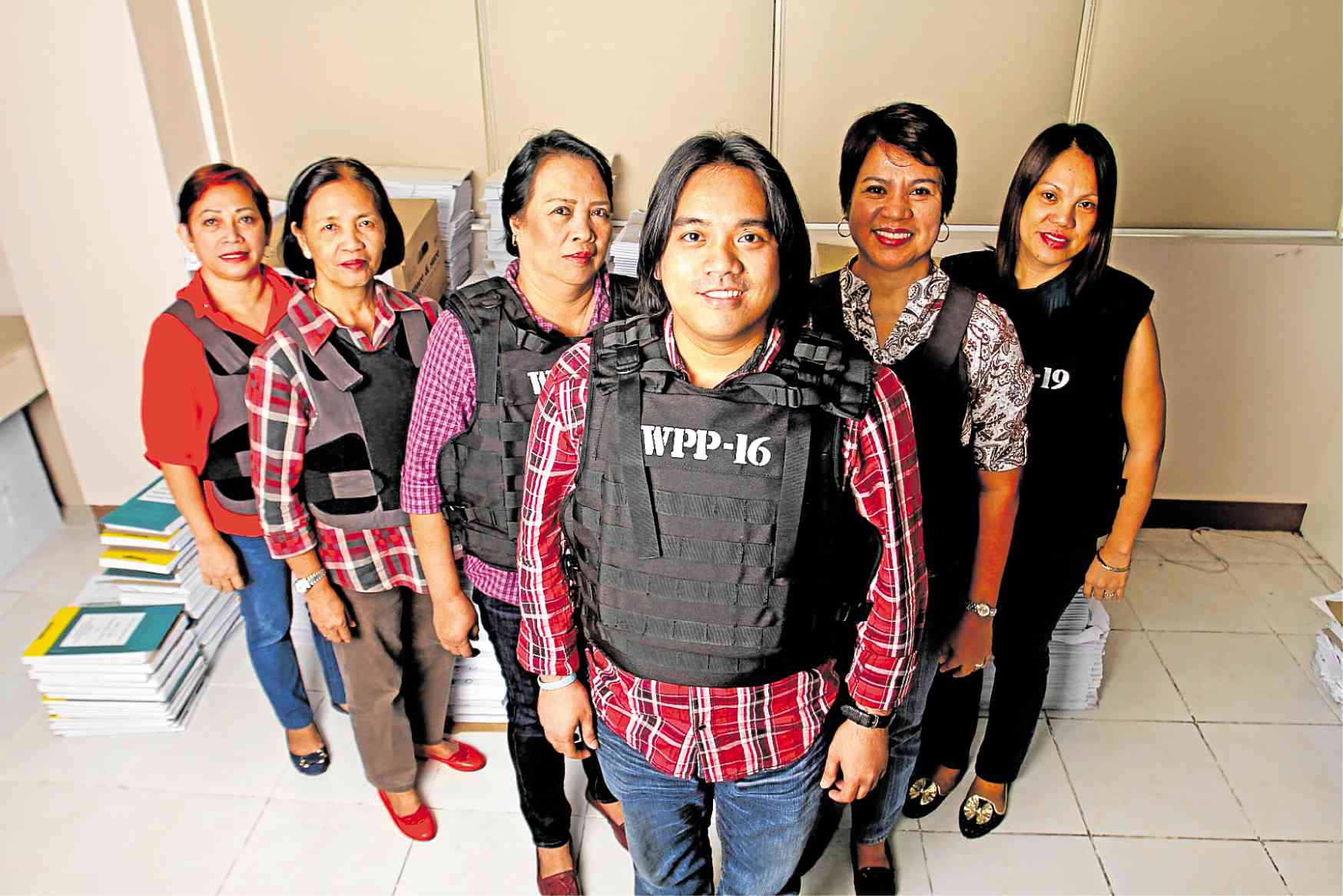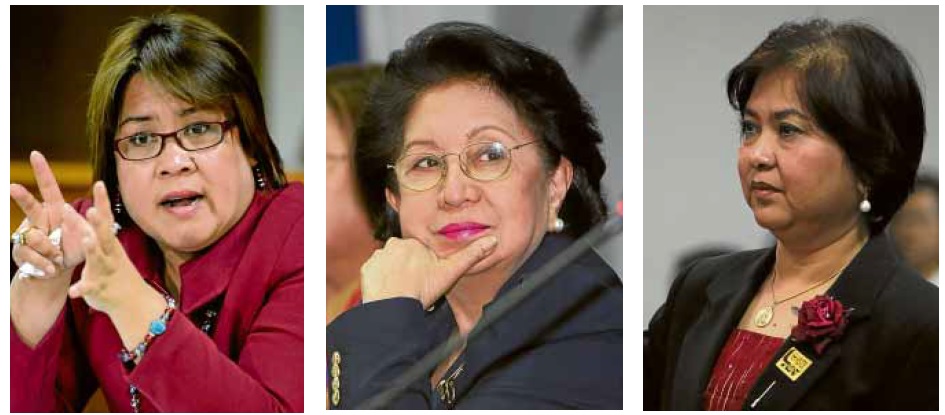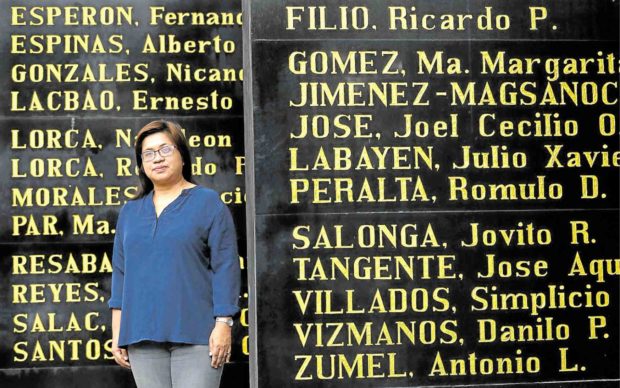Men and women for all seasons
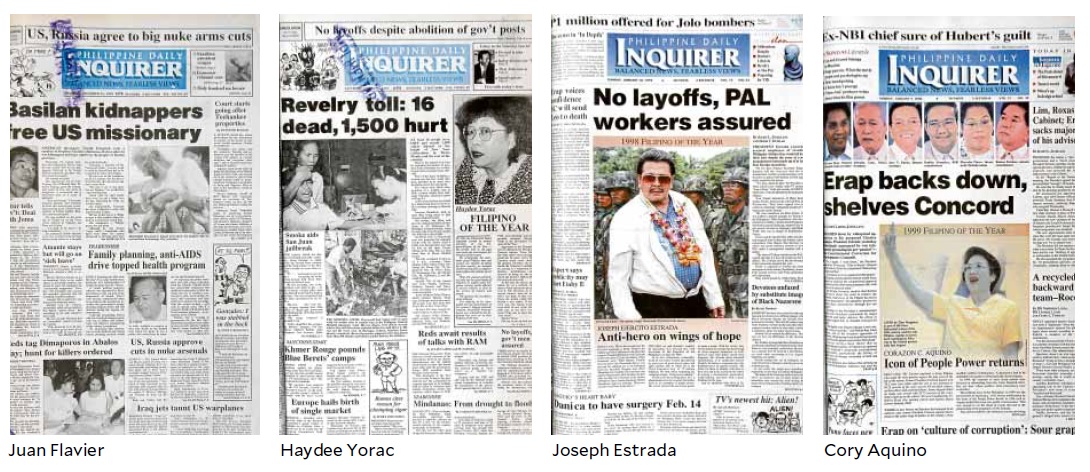 Every year since 1991, the Inquirer has celebrated outstanding men and women for their indomitable spirit, their selfless will to serve and even die for others, and their single-minded resolve to reform society and thwart any attempt to undermine Philippine democracy’s hard-won freedoms.
Every year since 1991, the Inquirer has celebrated outstanding men and women for their indomitable spirit, their selfless will to serve and even die for others, and their single-minded resolve to reform society and thwart any attempt to undermine Philippine democracy’s hard-won freedoms.
From a construction worker to disaster volunteers, from a mayor to Presidents, from a priest to a lay leader, from Supreme Court justices to millennials, from Manny Pacquiao to Fernando Poe Jr., from bloggers to whistleblowers, the Filipino of the Year stood out and shone during the country’s darkest days.
By championing them, the Inquirer hopes to spread their light, share their gospel of hope, and nudge the rest of the Filipinos into action.
We look back and pay homage to the Inquirer’s Filipino of the Year (FOTY) honorees. May their spirit of greatness prevail and infect many more.
1991: Raymundo Punongbayan
When Mt. Pinatubo erupted on June 15, 1991, it was Punongbayan, a geologist with the Philippine Institute of Volcanology and Seismology, who shepherded the nation out of chaos and ignorance with his calm and reassuring media presence.
1992: Haydee Yorac
As head of the Commission on Elections from 1986 to 1992, the no-nonsense Yorac made it possible for the country to have one of its cleanest elections ever. Later, as chair of the National Unification Commission, she brought Muslim rebels and the military to the negotiating table, offering hope for the country’s dream of unity.
1993: Juan Flavier
This jovial health secretary during the Ramos administration gave Filipinos a lot of reasons to smile about, aside from his disarming sense of humor. His inclusive health programs—from AIDS awareness to immunization for rebels, doctors to the barrio, fortified rice, breastfeeding, herbal medicine and planting that backyard wonder “malunggay”—endeared him to the masses, who later elected him to the Senate.
1994: Overseas Filipino Workers
From 1985 to 1993, some 3.6 million Filipinos left for foreign shores to give their families a better life. Their remittances, which run into billions of dollars, bailed out the country and earned them praise as modern-day heroes. In truth, by putting up with the searing pain of separation and risking abuse, they are more like latter-day saints.
1995: The Filipino Everyman
This was the year Filipinos sank so low as victims that they had no choice but to hoist themselves up to become victors again. Barely surviving what seemed to be an endless string of natural disasters—floods, mudslides, sea mishaps—Filipinos also had to contend with the worst crime wave the country had ever seen, not to mention the hanging of one of their own in a foreign land. Somehow they muddled through and endured.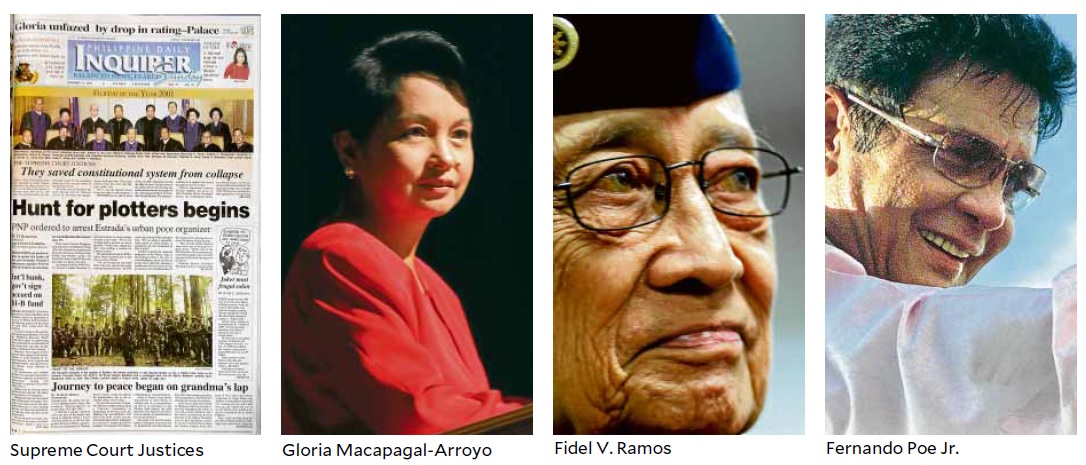
1996: Fidel V. Ramos
As the country’s 12th President, Ramos steered the republic toward economic recovery and its goal of peace in Mindanao. During his watch, the economy got a timely boost from a radically reformed tax system, the wider participation of private business, and investments from Apec nations. A former military man, Ramos pursued and negotiated the first peace agreement with the separatist Moro National Liberation Front.
1997: Corazon Aquino and Jaime Cardinal Sin
Eleven years after playing a key role in the 1986 Edsa People Power Revolution, former President Cory Aquino and Jaime Cardinal Sin mobilized mass action against an attempt to rewrite the 1987 Constitution. The widow and the cardinal summoned a mammoth crowd to Luneta in Manila on Sept. 21, 1997, to protest the administration’s initiative to extend the six-year term of President Ramos, himself a fellow key player in the 1986 bloodless revolt that toppled strongman Ferdinand Marcos. Reading the writing on the wall, Mr. Ramos declared a day before the rally that he was not running for reelection, “period, period, period.”
1998: Joseph “Erap” Estrada
He proved that the poor has the power to elect a President. With his victory, the masses declared that they have had enough of savvy politicians who didn’t walk their talk. Erap, after all, had been their movie idol and their go-to guy as he rose through the political ranks, from mayor of San Juan to senator, to vice president and finally, Chief Executive.
1999: Corazon Aquino
Cory Aquino strode back into the political limelight and, together with Manila Archbishop Jaime Cardinal Sin, mobilized protests against the Estrada administration, which was then hatching a plan to revise the Constitution amid allegations of corruption. On Aug. 21, 1999, the 16th anniversary of her husband’s assassination, the former President brought together the Left, civil society groups and business leaders to face down anew this threat to the country’s democratic institutions.
2000: Hilario Davide Jr.
When he presided over the impeachment trial of President Estrada, the former Chief Justice firmly upheld the primacy of the constitutional process. He imbued the trial with credibility by setting a stringent standard of fairness that showcased democracy at work.
2001: Supreme Court Justices
On Jan. 20, 2001, the nation teetered on the edge of chaos after negotiations for then Vice President Gloria Macapagal-Arroyo to take over from disgraced President Estrada broke down. To prevent the country from plunging into civil war, 12 of the 15 justices signed a resolution clearing the way for Chief Justice Hilario Davide to swear in Arroyo as President, legitimizing a nonviolent transfer of power to a new government.
2002: Gloria Macapagal-Arroyo
On Dec. 30, 2002, Gloria Macapagal-Arroyo stunned the nation when she announced that she would forgo any presidential run in 2004 and just spend the rest of her term healing a “deeply divided” country. In effect, she redefined the rules of politics, and even its culture. She would later break that promise.
2003: Manny Pacquiao
The boxing champ brought cheer to a nation blighted by war, epidemic, mutiny, corruption scandals and sleazy politics after he demolished Mexican legend Marco Antonio Barrera in San Antonio, Texas, in November 2003.
2004: Fernando Poe Jr.
Peasant, peon, cowboy, blacksmith, soldier—Fernando Poe Jr. played them all in his blockbuster movies. Buoyed by the hero worship, the actor gunned for the presidency in 2004, but lost a close fight to Gloria Macapagal-Arroyo in a vote marred by allegations of fraud. Months after his heartbreaking defeat, he had a stroke and died on Dec. 14, 2004.
2005: SEA Games Filipino athletes
Weighed down by the “Hello Garci” election scandal, the impeachment war and runaway oil prices, Filipinos ended the year on a bright note, thanks to the country’s strong showing in the 23rd Southeast Asian (SEA) Games. The local athletes hauled a total of 113 gold medals, 84 silvers and 94 bronzes.
2006: Antonio Meloto
California-based Filipinos supported the very first Gawad Kalinga (GK) community of 2,000 homes for indigent families at Bagong Silang, Caloocan City. That more GK villages would soon follow was a testament to Meloto’s knack for sourcing funds as well as for mobilizing volunteers. By 2006, GK had become a global template for development.
2007: Eduardo “Among Ed” Panlilio
Who would have thought that a Catholic priest would run for public office and win? The people of Pampanga, tired of the business-as-usual politics, rallied behind Panlilio and voted him into office. He remained a priest but was suspended from performing priestly duties when he was elected Pampanga governor. Despite threats of a vote recount and a recall election, he introduced reforms that quadrupled the province’s income from lahar quarrying, giving his cabalen a ray of hope at a time of deep despair from national politics.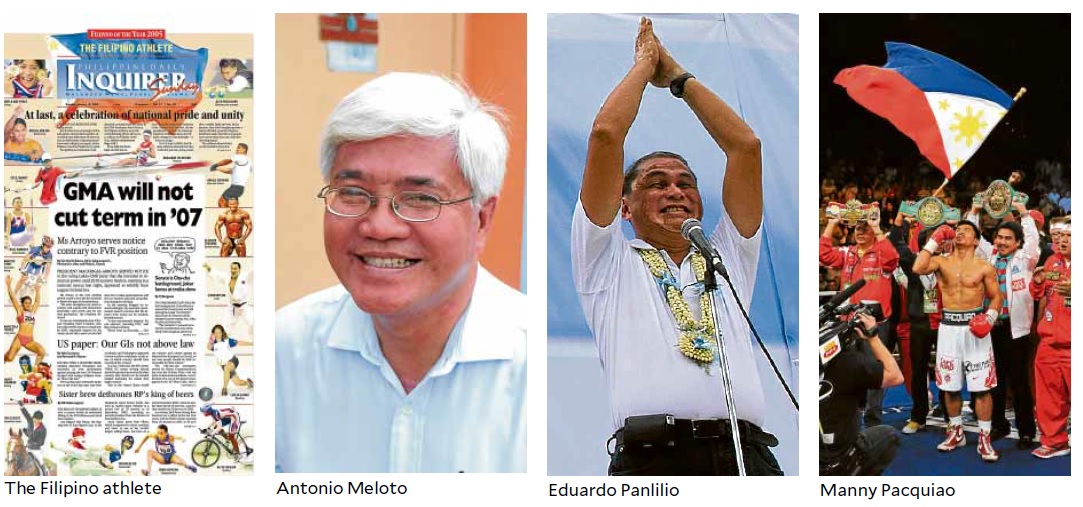
2008: Manny Pacquiao
Since first being named Filipino of the Year in 2003, Manny Pacquiao has defended the WBC Super Featherweight International title five times. In 2008 alone, having reinvested enormous discipline into his pugilist craft, Pacquiao won three boxing titles: the RING Super Featherweight title, the WBC Super Featherweight title and the WBC Lightweight title.
2009: “Ondoy” volunteers
Tropical storm “Ondoy” (international name: Ketsana) brought the worst flooding to Metro Manila and surrounding provinces in 40 years, but its fury was no match to the scale of the humanitarian response received by its five million victims. Construction worker Muelmar Magallanes, 18, dove into the raging flood to save 30 lives before losing his own. He was hailed as one of Time Magazine’s top 10 heroes of the year. Quezon City Judge Ralph Lee used his jet ski to ferry about a hundred of his trapped neighbors to safety, while the Kalinisan Steam Laundry Inc. offered its services for free—just a few of the volunteers who rose above these murky times.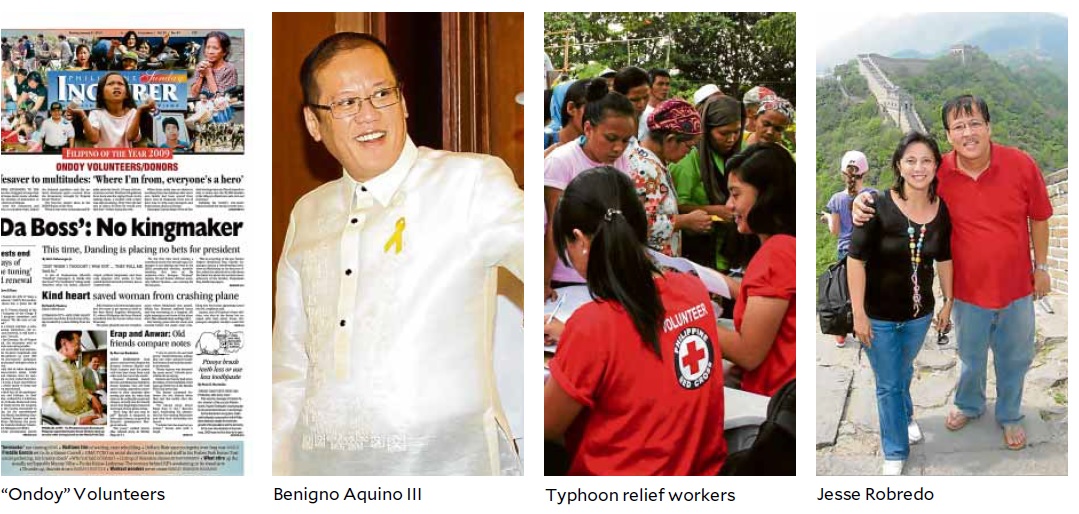
2010: Benigno Aquino III
Most Filipinos believed his thrilling declaration (“Kayo ang boss ko!”), felt that he was within reach despite his old-rich pedigree, and saw how he had embodied the incorruptible character of his mother, the late President Cory Aquino. In its FOTY tribute, the Inquirer described P-Noy as “the living Filipino who made the most positive impact in 2010.”
2011: Disaster responders and volunteers
Were an artist to piece together a collage of the names and faces of the rescuers, relief workers, volunteers and donors who stood and delivered during and in the aftermath of Tropical Storm “Sendong” and other calamities in 2011, the resulting artwork would look, without doubt, lit from within. From a guard who donated his Christmas pack, to a corporate donation of P500 million for house construction, each deed has a good heart beating at its core.
2012: Jesse Robredo
The unexpected death in a plane crash of Interior Secretary Jesse Robredo only highlighted how well his life had been lived. Often shod in lowly slippers, the legendary mayor of Naga City from 1988 to 1998 turned around this backwater in thrall to crime syndicates to a first-class city. His death brought shock and sorrow over the loss of a robust public official, a tender family man and “the best President the Philippines never had.”
2013: Benhur Luy and his fellow whistleblowers
Imagine a bunch of minnows putting up a fight against a school of sharks. Benhur Luy and his fellow whistleblowers—a band of record-keepers, personal assistants, clerks, gofers, drivers and a nanny—have blown the lid off the biggest corruption scandal in the country. The group exposed how billions of pesos in pork barrel funds had been diverted in a scam engineered by their employer, business woman Janet Lim-Napoles, and a cabal of lawmakers using bogus organizations and ghost projects.
2014: Leila de Lima, Conchita Carpio Morales and Grace Pulido-Tan
Dubbed “Tres Marias” by the editors, the triumvirate of Justice Secretary Leila de Lima, Ombudsman Conchita Carpio Morales and Commission on Audit chair Grace Pulido-Tan, might as well be the “Three Furies” for their feisty stand against graft and corruption despite obstacles, harassment and intimidation.
2015: Letty Jimenez–Magsanoc
More than being the esteemed editor in chief of the Inquirer, LJM—who passed away on Dec. 24, 2015—was a courageous Filipino who wielded a sharp and incisive pen fighting for press freedom from the martial law years of ousted President Marcos through the succeeding administrations.

LETTY JIMENEZ MAGSANOC She wielded a sharp, incisive pen fighting for press freedom from the Marcos years through succeeding administrations.
2016: The Antirevisionists, millennials, five SC justices, martial law victims
The first protest actions after Marcos’ controversial hero’s burial were spontaneous affairs led by young people scandalized by what the dictator’s heirs had done. In subsequent rallies, the most important testimony came from martial law victims, followed by then Chief Justice Maria Lourdes Sereno, Senior Associate Justice Antonio Carpio, and Associate Justices Marvic Leonen, Francis Jardeleza and Alfredo Benjamin Caguioa who ndissented from the majority ruling that allowed the interment of the dictator’s remains at Libingan ng mga Bayani.
2017: Pinoy Ako Blog and other voices against fake news
In a year that saw the beginning of a pushback against the organized production and distribution of false information, the blogger Jover Laurio— the lone, once-anonymous, much -abused person behind Pinoy Ako Blog—stood out for the frequency and freshness of her patriotic posts, the dark humor of her observations, and, not least, the courage she showed in the face of overwhelming personal attacks.
2018: Judges who gave hope in the fight against impunity
By their decisions on certain critical cases, Regional Trial Court Judges Rodolfo Azucena Jr., Arlene Lirag Palabrica, Andres Soriano and Alexander Tamayo fired up the people’s despondent imagination and gave new reasons for the public to think that things could get better, that there might be a way out of this slough. Three of the cases involved uniformed men, while the fourth involved a senator of the realm, himself a former military man. The judges’ decisions chipped away at the perception of an intimidated judiciary. Collectively, they represented a bracing breeze blowing into musty courtrooms, speaking truth to power in a period that badly called for a principled stand.











